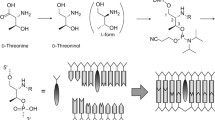Abstract
Nucleobase-caged oligonucleotide residues have photolabile “caging groups” that prevent the formation of Watson–Crick base pairs until the unmodified nucleobase is restored in a photolysis event. This principle can be used to put a growing variety of powerful nucleic acid-based applications under the precise spatiotemporal control using light as an addressing mechanism. Examples for applications include light control of transcription, RNAi, nucleic acid folding, primer extension, and restriction endonuclease as well as DNAzyme, aptamer, and antisense activity. However, a comparison of the duplex-destabilization properties of the various caged residues that have been used up to date and rules for achieving a maximal duplex destabilization with a minimum amount of modified residues are still missing. We present both a comparison of the duplex-destabilizing capabilities of various nucleobase-caged residues and address the question of influence on neighboring base pairs.

Nucleobase-caged nucleosides act as mismatches until irradiation with UV light which cleaves off the caging group. This technology allows to add spatiotemporal control over nucleic acid-based applications. This study provides a first systematic evaluation of residues that have been presented in individual studies over the recent years and tries to establish rules for their optimal use.








Similar content being viewed by others
References
Kaplan JH, Forbush B III, Hoffman JF (1978) Biochemistry 17:1929–1935
Engels J, Schlaeger EJ (1977) J Med Chem 20:907–911
Deiters A (2009) Curr Opin Chem Biol 13:678–686
Young DD (2007) Org Biomol Chem 5:999–1005
Ellis-Davies GCR (2007) Nat Methods 4:619–628
Tang X, Dmochowski IJ (2007) Mol Biosyst 3:100–110
Fürtig B, Buck J, Manoharan V, Bermel W, Jäschke A, Wenter P, Pitsch S, Schwalbe H (2007) Biopolymers 86:360–383
Mayer G, Heckel A (2006) Angew Chem Int Ed 45:4900–4921
Lawrence DS (2005) Curr Opin Chem Biol 9:570–575
Goeldner M, Givens R (2005) Dynamic studies in biology. Wiley-VCH, Weinheim
Ando H, Furuta T, Tsien RY, Okamoto H (2001) Nat Genet 28:317–325
Monroe WT, McQuain MM, Chang MS, Alexander JS, Haselton FR (1999) J Biol Chem 274:20895–20900
Shah S, Rangarajan S, Friedman SH (2005) Angew Chem Int Ed 44:1328–1332
Shah S, Jain PK, Kala A, Karunakaran D, Friedman SH (2009) Nucl Acids Res 37:4508–4517
Pitsch S, Weiss PA, Wu X, Ackermann D, Honegger T (1999) Helv Chim Acta 82:1753–1761
Chaulk SG, MacMillan AM (2001) Angew Chem Int Ed 40:2149–2152
Tang X, Swaminathan J, Gewirtz AM, Dmochowski IJ (2008) Nucleic Acids Res 36:559–569
Richards JL, Tang X, Turetsky A, Dmochowski IJ (2008) Bioorg Med Chem Lett 18:6255–6258
Tang X, Maegawa S, Weinberg ES, Dmochowski IJ (2007) J Am Chem Soc 129:11000–11001
Shestopalov IA, Sinha S, Chen JK (2007) Nat Chem Biol 3:650–651
Kröck L, Heckel A (2005) Angew Chem Int Ed 44:471–473
Wenter P, Fürtig B, Hainard A, Schwalbe H, Pitsch S (2005) Angew Chem Int Ed 44:2600–2603
Höbartner C, Silverman SK (2005) Angew Chem Int Ed 44:7305–7309
Young DD, Lusic H, Lively MO, Yoder JA, Deiters A (2008) Chembiochem 9:2937–2940
Lusic H, Lively MO, Deiters A (2008) Mol Biosyst 4:508–511
Mikat V, Heckel A (2007) RNA 13:2341–2347
Kuzuya A, Okada F, Komiyama M (2009) Bioconjugate Chem 20:1924–1929
Young DD, Lusic H, Lively MO, Deiters A (2009) Nucl Acids Res 37:e58
Young DD, Govan JM, Lievely MO, Deiters A (2009) Chembiochem 10:1612–1616
Heckel A, Mayer G (2005) J Am Chem Soc 127:822–823
Mayer G, Kröck L, Mikat V, Engeser M, Heckel A (2005) Chembiochem 6:1966–1970
Mayer G, Müller J, Mack T, Freitag DF, Höver T, Pötzsch B, Heckel A (2009) Chembiochem 10:654–657
Heckel A, Buff MCR, Raddatz MSL, Müller J, Pötzsch B, Mayer G (2006) Angew Chem Int Ed 45:6748–6750
Mayer G, Lohberger A, Butzen S, Pofahl M, Blind M, Heckel A (2009) Bioorg Med Chem Lett 19:6561–6564
Buff MCR, Schäfer F, Wulffen B, Müller J, Pötzsch B, Heckel A, Mayer G (2010) Nucleic Acids Res 38:2111–2118
Walbert S, Pfleiderer W, Steiner UE (2001) Helv Chim Acta 84:1601–1611
Lusic H, Young DD, Lively MO, Deiters A (2007) Org Lett 9:1903–1906
Mergny JL, Lacroix L (2003) Oligonucleotides 13:515–537
Puglisi JD, Tinoco I (1989) Methods Enzymol 180:304–325
Peyret N, Seneviratne PA, Allawi HT, SantaLucia J Jr (1999) Biochemistry 38:3468–3477
HYTHER™ version 1.0, Nicolas Peyret and John SantaLucia, Jr. Wayne State University.
SantaLucia J Jr (1998) Proc Natl Acad Sci USA 95:1460–1465
Jayapal P, Mayer G, Heckel A, Wennmohs F (2009) J Struct Biol 166:241–250
Petersheim M, Turner DH (1983) Biochemistry 22:256–263
Turner DH (1996) Curr Opin Struct Biol 6:299–304
Acknowledgements
This work was supported by the Deutsche Forschungsgemeinschaft (Emmy Noether Fellowship to A.H. and the Cluster of Excellence Macromolecular Complexes EXC 115 as well as the Frankfurt Institute for Molecular Life Sciences) and by the Alexander von Humboldt Foundation (Fellowship to K.B.J.). AH gratefully acknowledges the generous donation of silyl protecting group precursors by Wacker. We are also very grateful to the Steinhilber group for access to their PCR machine.
Author information
Authors and Affiliations
Corresponding author
Electronic supplementary materials
Below is the link to the electronic supplementary material.
ESM 1
(PDF 814 kb)
Rights and permissions
About this article
Cite this article
Rodrigues-Correia, A., Koeppel, M.B., Schäfer, F. et al. Comparison of the duplex-destabilizing effects of nucleobase-caged oligonucleotides. Anal Bioanal Chem 399, 441–447 (2011). https://doi.org/10.1007/s00216-010-4274-7
Received:
Revised:
Accepted:
Published:
Issue Date:
DOI: https://doi.org/10.1007/s00216-010-4274-7




